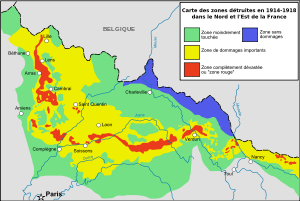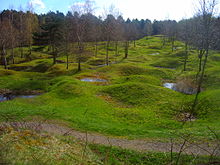

You can help expand this article with text translated from the corresponding article in French. (June 2012) Click [show] for important translation instructions.
Content in this edit is translated from the existing French Wikipedia article at [[:fr:Zone rouge (séquelles de guerre)]]; see its history for attribution.{{Translated|fr|Zone rouge (séquelles de guerre)}} to the talk page. |
50°22′N 2°48′E / 50.36°N 2.80°E / 50.36; 2.80



The zone rouge (English: red zone) is a chain of non-contiguous areas throughout northeastern France that the French government isolated after the First World War. The land, which originally covered more than 1,200 square kilometres (460 square miles), was deemed too physically and environmentally damaged by conflict for human habitation. Rather than attempt to immediately clean up the former battlefields, the land was allowed to return to nature. Restrictions within the Zone Rouge still exist today, although the control areas have been greatly reduced.
The zone rouge was defined just after the war as "Completely devastated. Damage to properties: 100%. Damage to Agriculture: 100%. Impossible to clean. Human life impossible".[1]
Under French law, activities such as housing, farming, or forestry were temporarily or permanently forbidden in the Zone Rouge, because of the vast amounts of human and animal remains, and millions of items of unexploded ordnance contaminating the land. Some towns and villages were never permitted to be rebuilt after the war.
The areas are saturated with unexploded shells (including many gas shells), grenades, and rusting ammunition. Soils were heavily polluted by lead, mercury, chlorine, arsenic, various dangerous gases, acids, and human and animal remains.[1] The area was also littered with ammunition depots and chemical plants. The land of the Western Front is covered in old trenches and shell holes.
Each year, numerous unexploded shells are recovered from former WWI battlefields in what is known as the iron harvest. According to the Sécurité Civile, the French agency in charge of the land management of Zone Rouge, 300 to 700 more years at this current rate will be needed to clean the area completely.[2] Some experiments conducted in 2005–06 discovered up to 300 shells per hectare (120 per acre) in the top 15 centimetres (5.9 inches) of soil in the worst areas.[3]
Areas where 99% of all plants still die remain off limits (for example, two small pieces of land close to Ypres and the Woëvre), as arsenic constitutes up to 175,907 milligrams per kilogram in soil samples because arsenical shells were destroyed by thermal treatment in 1920s.[4]